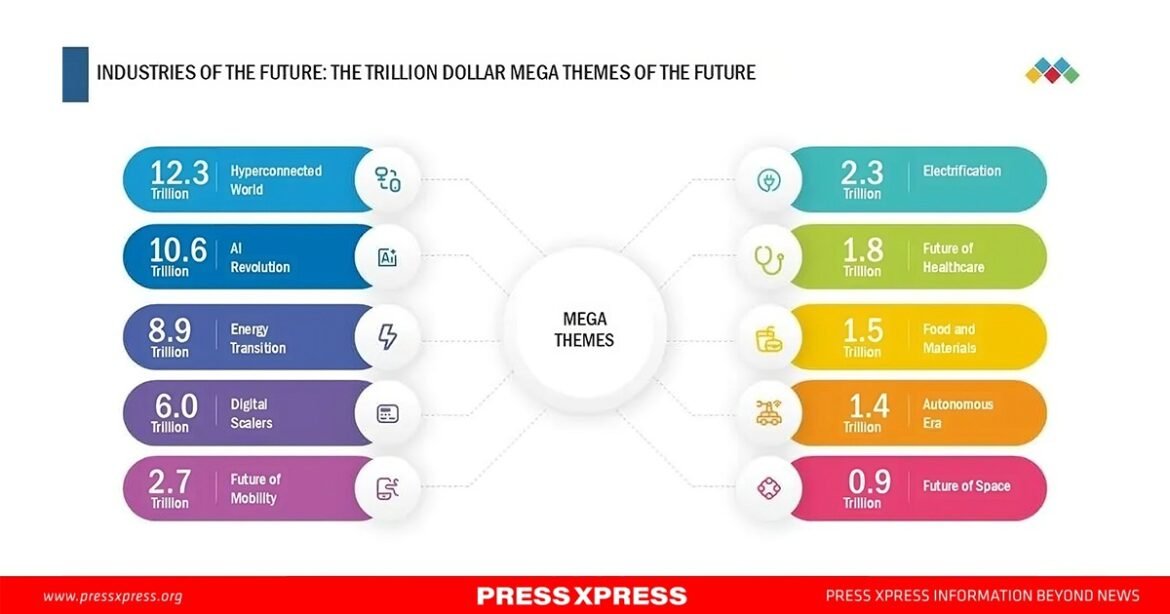As we stand at the cusp of the Fifth Industrial Revolution, the possibilities seem limitless.
The global economy stands on the brink of a monumental transformation, propelling humanity from an agrarian society to a data-driven digital era. A recent report by MarketsandMarkets projects that 164 emerging industries will collectively contribute an astounding $35 trillion to the world economy by 2035.
This surge is primarily driven by advancements in technology and the transition to Industry 5.0, emphasizing automation, connectivity, and human-centric solutions.

The Evolution of Industrial Revolutions
The journey from the first industrial revolution to the impending fifth has been marked by significant milestones:
- First Industrial Revolution: Initiated in the late 18th century, it transitioned economies from agriculture to industry with innovations like the steam engine and mechanized textile production.
- Second Industrial Revolution: Spanning the late 19th and early 20th centuries, it introduced electricity, leading to mass production and the rise of industries such as steel and telecommunications.
- Third Industrial Revolution: Commencing in the mid-20th century, it ushered in the digital age with computers and the internet, fostering globalization and the knowledge economy.
- Fourth Industrial Revolution: Characterized by breakthroughs in artificial intelligence (AI), machine learning (ML), and the Internet of Things (IoT), it has reshaped industries through data-driven decision-making and automation.
- Fifth Industrial Revolution (Industry 5.0): On the horizon, this revolution focuses on collaboration between humans and machines, aiming for personalized production and sustainable solutions.

Decoding the $35 Trillion Opportunity
MarketsandMarkets’ analysis identifies ten mega themes that will drive this economic expansion:
- Hyperconnected World: Envisioning seamless connectivity through advancements in 5G, 6G, and smart infrastructure, this theme is projected to contribute $12.3 trillion by 2035.
- AI Revolution: The integration of AI across sectors promises automation of complex tasks and data-driven insights, with an estimated economic impact of $10.6 trillion.
- Energy Transition: Shifting from fossil fuels to renewable energy sources like solar, wind, and green hydrogen is expected to add $8.9 trillion to the global economy.
- Future of Mobility: Advancements in electric and autonomous vehicles, coupled with software-defined models, are set to revolutionize transportation, contributing $2.7 trillion.
- Electrification: Beyond mobility, electrification of various sectors, including infrastructure and industry, is projected to add $2.3 trillion.
- Future of Healthcare: Technological innovations in healthcare, such as AI-driven diagnostics and robotic surgeries, are anticipated to contribute $1.8 trillion.
- Food and Materials: Sustainable food production and the development of eco-friendly materials are expected to add $1.5 trillion to the economy.
- Autonomous Era: The rise of autonomous systems across various sectors is projected to contribute $1.4 trillion.
- Future of Space: Expanding activities in space exploration and satellite deployment are anticipated to add $0.9 trillion.
Implications for Global Economies
Emerging markets are poised to play a pivotal role in this economic transformation. S&P Global projects that by 2035, these markets will contribute about 65% of global economic growth, with countries like Vietnam, India, and the Philippines leading the charge.
Vietnam, for instance, is expected to achieve an average annual GDP growth of 6.2%, driven by policy consistency and integration into global supply chains. Similarly, India’s economy is projected to grow significantly, with ambitions to become a $10 trillion economy by 2035.
Challenges and Considerations
While the prospects are promising, several challenges must be addressed:
- Technological Displacement: The rapid adoption of automation and AI could lead to job displacement, necessitating reskilling and upskilling of the workforce.
- Sustainability Concerns: The energy transition requires substantial investment in renewable infrastructure and addressing the environmental impact of new technologies.
- Geopolitical Dynamics: The global shift in economic power may lead to geopolitical tensions, requiring diplomatic navigation to maintain stability.
The anticipated $35 trillion economic expansion underscores the transformative potential of emerging industries and technologies. As we stand on the cusp of Industry 5.0, the collaboration between humans and machines, coupled with sustainable practices, promises to redefine the global economic landscape. However, realizing this potential will require strategic investments, policy support, and a commitment to addressing the accompanying challenges.
As Sarwant Singh aptly notes, “The future is knowledge, and the future of industries is just the beginning.”


